Promoting your B2B SaaS brand might take a lot of work, especially in a cluttered and competitive market worth approximately $3 trillion.
To stand out in this domain and stay relevant, businesses should be agile enough to embrace the ever-changing buyer behavior and rapidly evolving technologies.
There is no magic bullet in B2B SaaS offerings, as what helps one company may not help another. With a range of marketing activities, the focus is gradually shifting to data-driven and revenue-centric tactics like revenue marketing.
Revenue Marketing As A Strategy
Staying ahead of the SaaS game requires businesses to effectively manage data and extract meaningful insights that can help in optimizing budgets, resources, and campaigns.
This means directing each marketing effort towards revenue generation, thus ensuring no money is wasted on less impactful campaigns. Data-driven marketing aims at leveraging data to optimize business processes and build a strong revenue-generation model. No wonder, revenue marketing is emerging strongly among data-driven businesses as it aligns the entire organization towards one goal – revenue generation.
So, what is revenue marketing? It’s a strategy where businesses aim all their efforts and investments towards building a steady stream of revenue. It focuses on achieving seamless alignment between sales and marketing teams, thereby yielding more revenue.
But implementing revenue marketing tactics isn’t a cakewalk. Let’s overview the most common mistakes businesses commit when navigating the revenue marketing maze.
The 5 Most Common SaaS Mistakes And How To Correct Them
SaaS Mistake #1. Neglecting customer lifetime value (CLTV) in ROI calculations
When implementing revenue marketing, SaaS marketers can consider the Return on Marketing Investment (ROMI) which determines campaigns’ effectiveness in generating revenue. However, it is wise to consider only some of the lifetime value of a customer to consider immediate returns.
Why would you do that?
This is because the SaaS business models typically rely on subscriptions where a customer’s actual value unfolds over time. Ignoring CLTV can lead to underestimating the worth of campaigns that bring long-term, high-value customers.
Therefore, successful revenue marketing requires a deep understanding and appreciation of the customer journey from acquisition to post-sale engagement because every touchpoint presents an opportunity to bolster revenue.
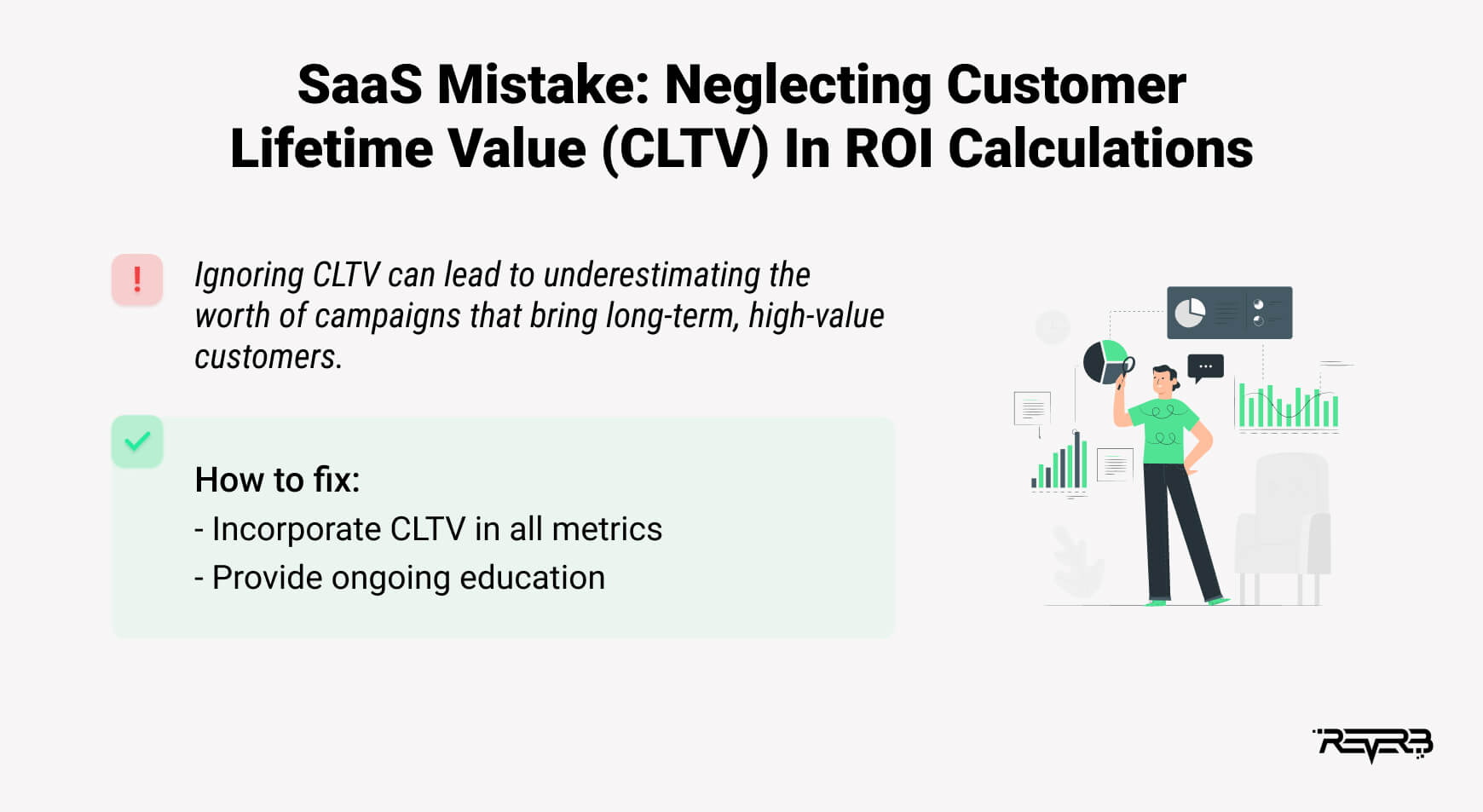
Correcting the mistake:
- Incorporate CLTV in all metrics: Begin with integrating the CLTV metric into all financial analyses and performance metrics. This comprehensive view ensures that marketing campaigns are evaluated based on long-term profitability rather than immediate returns. Overcoming this mistake requires a holistic approach for a more accurate picture of the long-term profitability of marketing campaigns.
- Ongoing education: Regularly train and remind the marketing team about the significance of CLTV, ensuring that it remains a focal point in strategic decision-making. Training and emphasizing its importance to the marketing team help SaaS businesses ensure that CLTV remains central in strategy formulation. Understanding and prioritizing CLTV in revenue marketing helps forecast long-term revenue streams, optimize resource allocation, and build more sustained and profitable customer relationships.
SaaS Mistake #2: Overemphasizing top-of-funnel activities
Generating SaaS leads is an essential aspect of the sales process, but marketers often place more importance on top-of-funnel (ToFu) activities.
How do they do so?
SaaS companies expend substantial resources on acquiring leads but need to improve when nurturing and converting them. Over-prioritizing ToFu activities without a balanced approach can lead to a vast pool of unengaged prospects that never convert into paying customers.
Moreover, you could forge and solidify customer relationships in the MoFu stage. Neglect this, and you will miss the opportunity to create a deeper connection with potential customers, resulting in missed sales opportunities and even a tarnished brand image.
Therefore, allocating the lion’s share of the budget for ToFu will not show conversions when you tie revenue with marketing strategies in the modern online environment. In turn, you’ll experience a low return on investment.
Also, when the sales team chases a vast pool of low-quality leads, they’ll spend more time sifting through them rather than focusing on genuine prospects.
The result?
Draining the employee morale and efficiency.
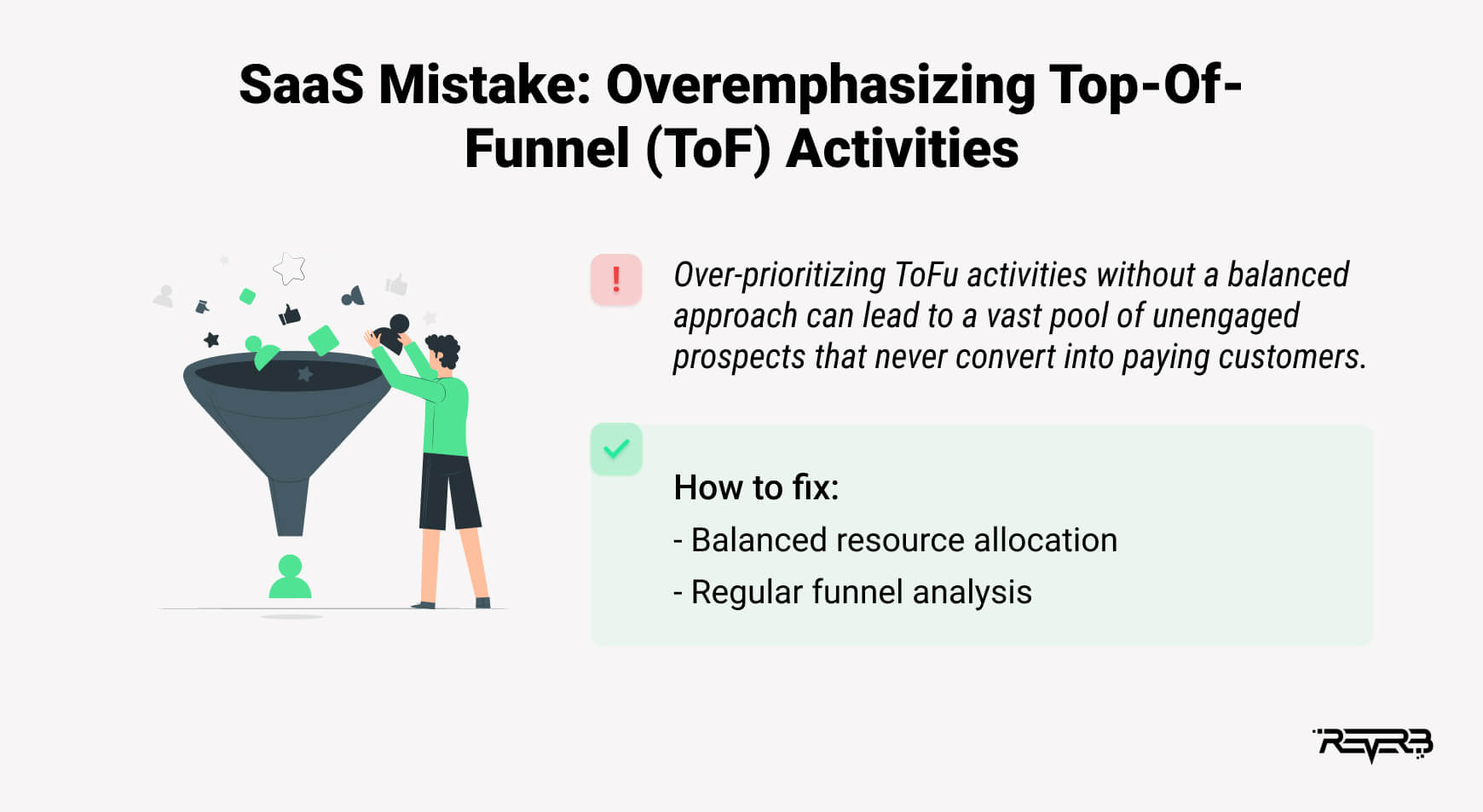
Correcting the mistake:
- Balanced resource allocation: Allocate resources to middle and bottom funnel activities, ensuring leads are effectively nurtured and converted. This includes investing in content for the middle-of-funnel (MoFu) and bottom-of-funnel (BoFu) stages. Therefore, allocate resources to produce content such as webinars, detailed guides, and case studies to nurture leads and move them closer to a buying decision.
- Regular funnel analysis: Once resources are allocated to each stage of the funnel, it is best to periodically assess the conversion rates at each stage. This helps identify bottlenecks or drop-offs to adjust strategies accordingly.
SaaS Mistake #3: Misaligned sales and marketing teams
Revenue marketing will need the sales and marketing teams to operate synergistically. When these two departments function in silos, there’s a significant risk of missed opportunities and miscommunication.
What happens then?
The seamless collaboration between sales and marketing teams forms the core of your revenue marketing. But, when these departments function separately, you are susceptible to overlooking potential leads that are missed opportunities. Such disconnect is a glaring revenue marketing error that SaaS firms must circumvent, especially in today’s digital age, where competition for customer retention is high.
Both teams invest significant effort in nurturing leads through tailored content and strategic campaigns. Yet, a lack of synchronization can derail these efforts. Misaligned sales and marketing teams can see these painstakingly nurtured leads fall through the cracks, leading to potential customers needing more attention.
A lead nurtured through marketing efforts can be lost in the transition to sales due to a lack of coordination. Therefore, this is a crucial revenue marketing mistake that SaaS firms should avoid.
The sales and marketing teams often work hard to nurture leads, identifying and engaging potential customers through content and campaigns.
But what happens when they are not in sync?
An out-of-sync sales and marketing team will witness these nurtured leads getting lost, not followed up on, or approached incorrectly, leading to lost sales.
When focusing on revenue marketing, the inability to work in tandem directly results in potential revenue loss. A lead that might have converted into a paying customer is lost due to miscommunication or lack of follow-up due to misalignment, depriving you of upselling or cross-selling effectively, leading to a lower LTV.
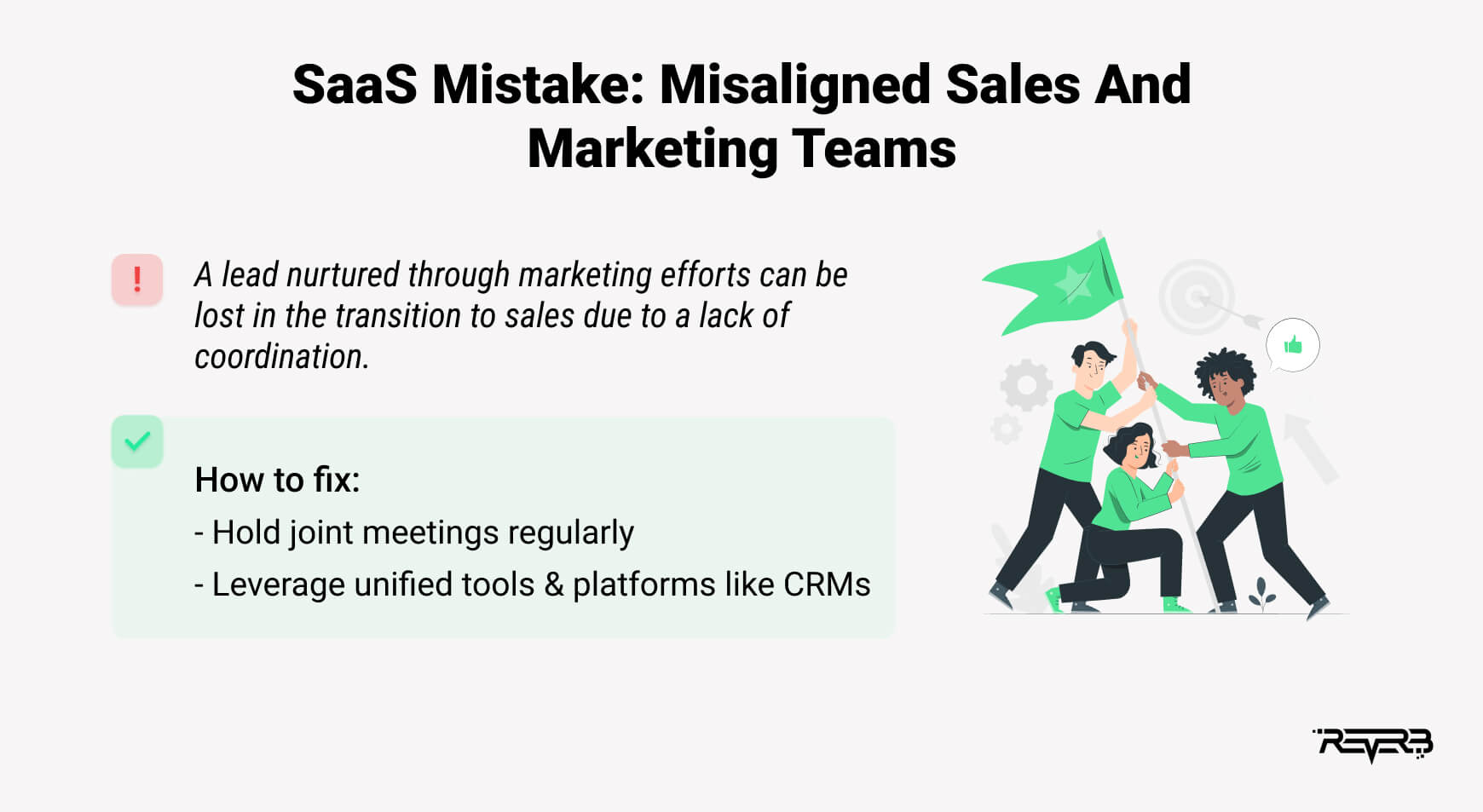
Correcting the mistake:
- Hold joint meetings regularly: Start conducting sales and marketing meetups to ensure both are aligned regarding goals, strategies, and understanding of the customer journey.
- Leverage unified tools & platforms: Implement CRM and marketing platforms that facilitate seamless communication and data sharing between the two teams. Both departments can access real-time data, ensuring every lead is included.
SaaS Mistake #4: Failing to update revenue attribution models regularly
Revenue attribution is a way for businesses to understand which marketing channels or touchpoints contribute to revenue generation. Distributing revenue to specific marketing activities helps SaaS businesses determine the most effective channels that deserve further investment.
But, SaaS marketers have to deal with plenty of emerging (marketing) channels as they catch up with the ever-evolving patterns (of choices). This is true for almost every aspect of the SaaS industry as developers keep themselves updated with the latest tools, security experts overlook the functioning of tools like CSPM to ensure the security and compliance of their cloud-based solutions, and even research teams come with innovation.
So, what about marketers? Let’s take an example.
A few years ago, Facebook might have been the prime platform for a specific demographic. Still, today, that demographic might spend more time on TikTok or another emerging platform like Threads or Twitter.
But what’s the mistake here?
Relying on something (platform) other than the traditional revenue attribution models is ideal to avoid misinterpreting the effectiveness of different marketing channels. So, review and update these models to ensure marketing efforts align with channels that deliver the best returns.
Therefore, SaaS businesses sticking to outdated attribution models might invest heavily in channels that no longer yield the desired ROI. At the same time, they might overlook emerging channels where their potential customers are now active. However, with a predefined (and finite) marketing budget, investing in a non-performing channel would mean a lesser budget for channels that could drive more revenue.
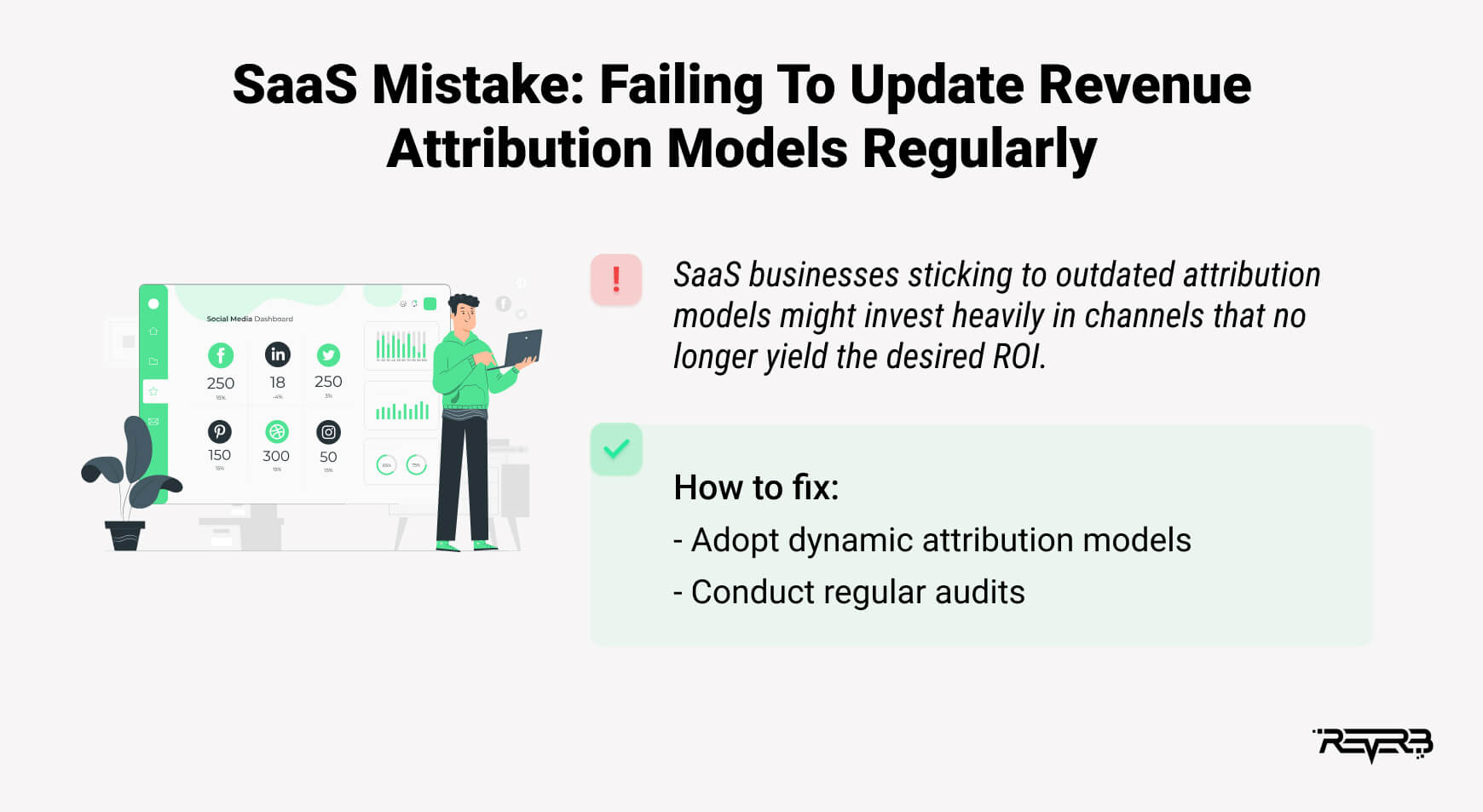
Correcting the mistake:
- Adopt dynamic attribution models: Instead of static models, SaaS marketers can adopt dynamic ones that are adjusted based on current data and emerging trends.
- Regular audits: Regularly audit your marketing results and attribution models to ensure they reflect the current marketing landscape and customer behaviors. You can always adjust your strategies based on these audited findings.
SaaS Mistake #5. Overlooking post-sales engagement
Lastly, a major SaaS revenue marketing mistake is that the marketers feel their job is done once the product is sold. But, the post-sale phase offers rich opportunities for upselling, cross-selling, and securing renewals.
For many SaaS businesses, the initial purchase is just the beginning since they often operate on subscription models. The continuous revenue comes from renewals, upsells, and cross-sells.
And what happens when you fail the post-sale engagement?
It leads to SaaS businesses needing to boost their CLTV, which puts them at risk of losing potential revenue and customer loyalty. The high churn rates can be catastrophic for SaaS businesses as they lose future revenue after heavily investing in acquiring that customer (also known as customer acquisition cost or CAC). Continuous post-sale engagement can help reduce churn by ensuring customers find continuous value in the product.
Effective revenue marketing should thus recognize the entire customer journey from lead generation to post-sale engagement as vital touch points. Therefore, post-sale marketing can help retain customers, saving money in the long run and ensuring a steady revenue stream.
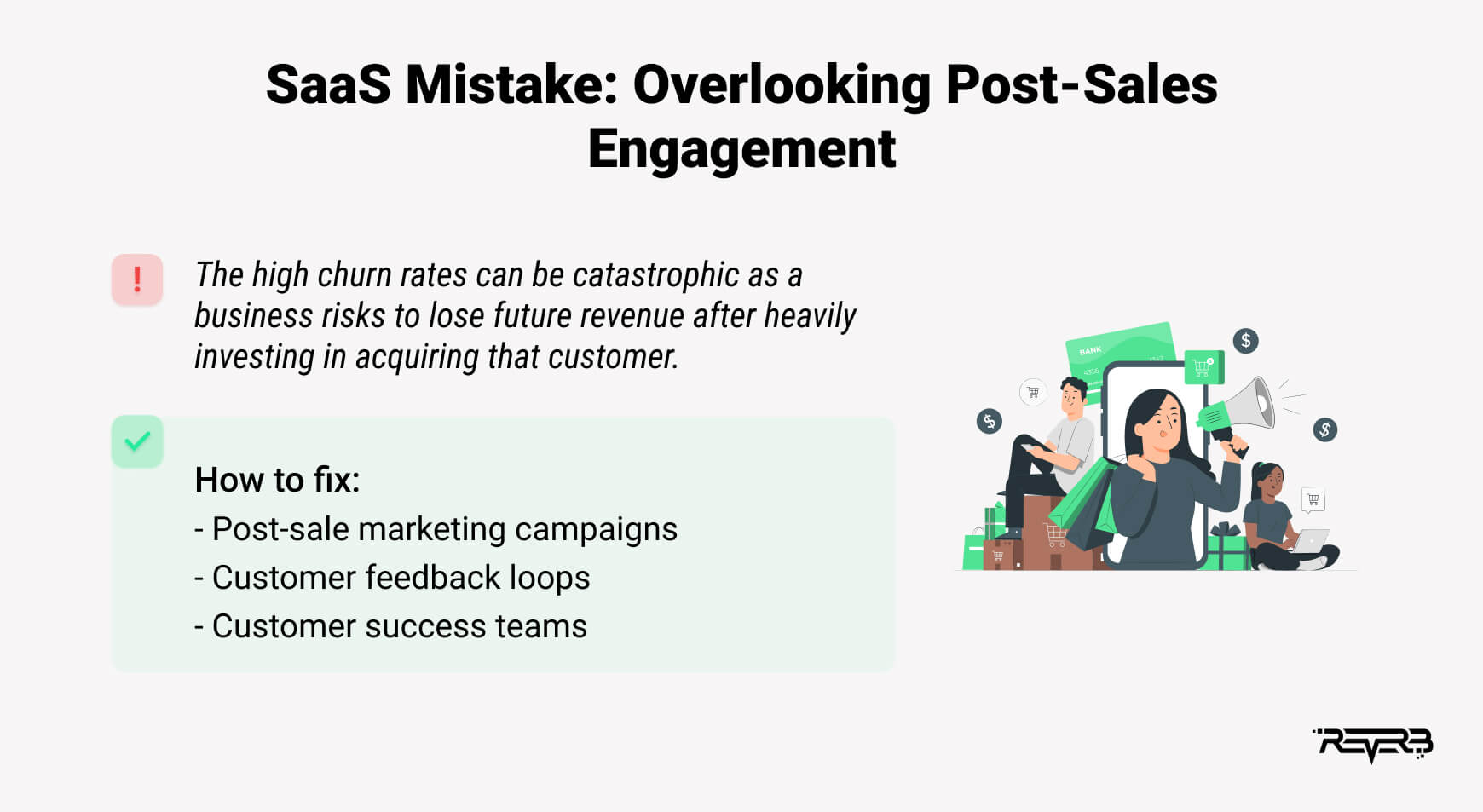
Correcting the mistake:
- Post-sale marketing campaigns: Consider implementing campaigns that specifically target current customers. Here, efforts are driven towards creating newsletters, webinars, or exclusive offers for upselling or cross-selling.
- Customer feedback loops: Create feedback loops with customers to understand their needs, concerns, and potential areas for further engagement. Not only does this help product development, but it also enables tailoring marketing strategies to meet customer needs.
- Customer success teams: A revenue marketing outlook requires considering dedicated customer success teams that focus on post-sale engagement. This ensures that customers derive maximum value from the product and address any concerns to reduce churn. Customer success tools can further empower these teams to proactively manage customer relationships, automate tasks, and gain valuable insights to drive success.
Conclusion
All said and done, as more marketers trust revenue marketing to boost their ROI, it requires a strategic approach to deal with common mistakes. The path to perfecting the revenue marketing strategy is marked with potential pitfalls and working in the right direction to overcome them.
Pivoting to a holistic customer journey requires aligning sales and marketing teams and consistently adapting to the ever-evolving digital marketing strategies to get better results from revenue marketing strategies.
As we move to a more digitally inclusive marketing world, SaaS marketers who have mastered the nuances of revenue marketing will undoubtedly lead the pack.
Contact ReVerb today to audit your marketing strategy. We’ll identify your crucial SaaS mistakes and gaps and help you set high standards for innovation, customer satisfaction, and, most importantly, sustainable revenue growth.









